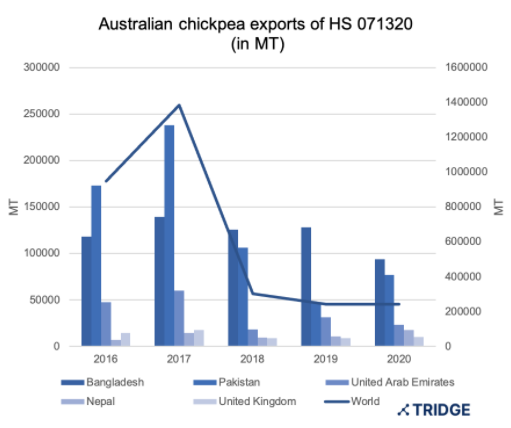Australian chickpea ongoing season
Australia is the biggest exporter of chickpeas globally, with 450,276 MT exported in 2020. Roughly 90% of the production is of Desi variety, and only 10% of the total production is Kabuli variety. Desi has smaller seeds of about 120 mg in weight each, and it is the preferred variety in Bangladesh. Kabuli has bigger seeds, about 400 mg in weight each, and is most appreciated in the Mediterranean region.
In 2020, the total Australian chickpea export value was worth USD 241,296 thousand, with the main importers being Bangladesh (38.89%), Pakistan (31.95%), United Arab Emirates (9.61%), Nepal (7.18%), and the UK (4.18%). Chickpea is a winter crop, and the harvesting season is between October up to January. Up to 2017, the Australian chickpea production was on a positive trend, due to favorable weather and growth in the planting area, reaching 2,004,000 MT in total production volume. However, in 2018 and 2019, Australia was devastated by severe droughts in the production areas and bushfires that reduced the production of 2018 to 205,100 MT. Since then, Australia has been rebuilding the affected areas. The production of MY 2020/21 is estimated at near-record 755,00 to 802,000 MT, according to Pulse Australia (PA) and the Australian Bureau of Agricultural and Resources Economics and Sciences (ABARES).

Source: Tridge, ITC
Farmers were initially concerned with the absorption of the near-record volume and held back stocks. This would keep firm prices up to October when the new crop comes in. However, the current crop has shown very good results and is expected to export 630,505 MT by the end of April. Up to March, the main importers of Australian chickpeas were Bangladesh and Pakistan. With the beginning of Ramadan, which started on April 12 and lasting until May 11, the exports have dropped to those countries. However, future volumes have been secured up to October, showing a firm demand. Prices were affected upward by the strong demand from Bangladesh and the scarcity of containers to supply the Pakistani container-based market reaching USD 670/MT since February. The uplift in prices helped farmers to sell instead of stocking. As a result, the carryover for the next season is expected to be smaller than usual and be up to 100,000 MT, erasing initial concerns of farmers on the absorption of the near-record crop.
The chickpea sowing in the following season is expected to begin at the end of May. The moisture of subsoils on the production areas from New South Wales to Central Queensland is in its best condition due to rain abundance. However, according to estimates by the Australian government, the next crop is expected to achieve a smaller volume compared to the near-record production in this crop. The soil is depleted of nutrients and no increase in the planted area is expected. The main importers of Australian chickpeas are expected to continue to be Bangladesh and Pakistan. The Australian government is in negotiations with the Indian government to decrease the chickpea import tax of 60% imposed in March 2018. This has greatly decreased the exports of Australian chickpeas to India and farmers wait for the outcome of negotiations to resume exports to India.
Sources:
- ABC. "Chickpea crop threatened by rain"
- Grain Central. "Australia's November chickpea exports up to 82pc lentils up to 3pc".
- Grain Central. "Pulse market looks to India for additional demand"
- Pulse AUS. "Australian industry almost entirely for human consumption"





